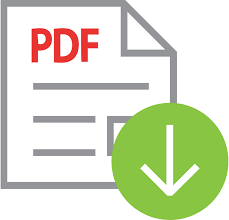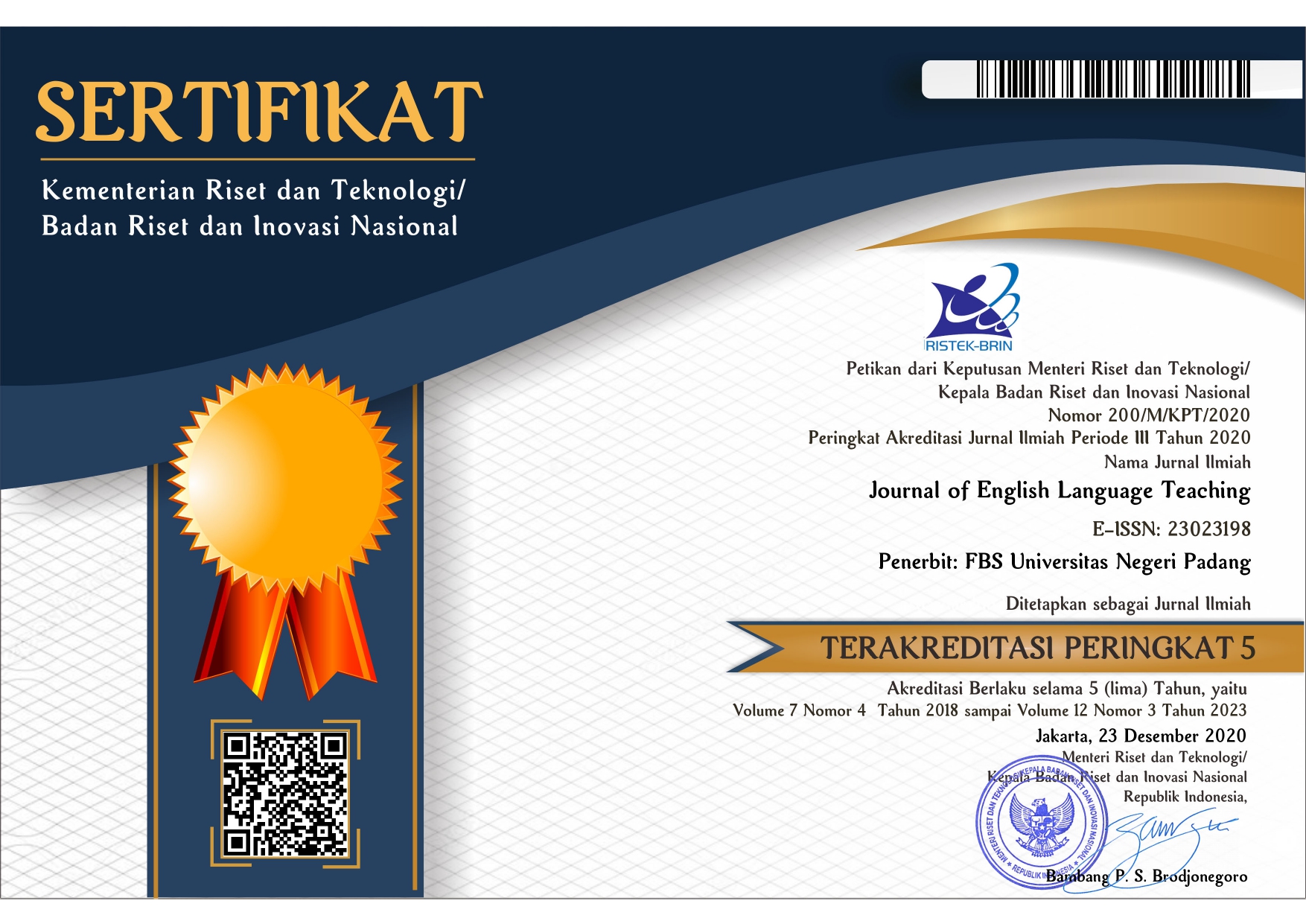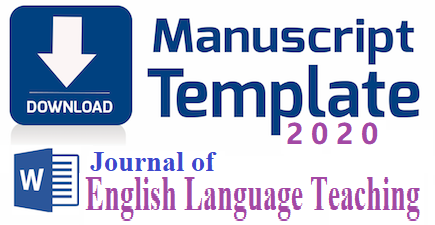The Analysis of Teacher’s Wait Time 1 in EFL Classroom at Junior High Schools in Padang
 ), Yetti Zainil(2),
), Yetti Zainil(2), (1) Universitas Negeri Padang
(2) Universitas Negeri Padang
 Corresponding Author
Corresponding Author
Copyright (c) 2021 Hanifha Kemalasari
DOI : https://doi.org/10.24036/jelt.v10i4.114968
Full Text:
 Language : en
Language : en
Abstract
References
Arikunto, S. (2010). Prosedur penelitian suatu pendekatan praktek.
Jakarta: Rineka Cipta.
Alsaadi, N, S. M., & Atar, C. (2019). Wait-time in material and
classroom context modes. International Journal of
Contemporary Educational Research..
DOI:https://doi.org/10.33200/ijcer.542495.
Atar, C. (2020) entitled "The Implementation of awareness raising for
pre-service teachers' management of classroom interaction with a
focus on extended wait-time"
Brown (2007). Principles of Language Learning and Teaching (5th
ed.). New York: Pearson Longman.
Camden, Sally. Wait Time Techniques. The reflective educator.
https://thereflectiveeducator.com/wait-time-techniques/
Daslin & Zainil (2020). Teachers’ Use of Wait Time: A Case Study of
Questioning Strategies in SMAN Padang. Journal of English
Language Teaching DOI
: https://doi.org/10.24036/jelt.v9i4.110338
Darwan Syah, Strategi Belajar Mengajar, Jakarta: Diadit Media, 2009
David A. Jacobsen, Methods For for Teaching (Metode-Metode
Pengajaran Meningkatkan Belajar Siswa TK-SMA), Pustaka
Pelajar, Yogyakarta, 2009
Granato, J. M. (1983). The effects of wait time on the verbal behavior
of kindergarten children. The Annual Conference of the New
England Educational Research Organization. Rockport, ME
Hisyam Zaini, Strategi Pembelajaran Aktif, Yogyakarta: Insan Madani
CTSD, Edisi Revisi, 2008
Iksan & Esther Daniel (2016) .Types of Wait Time during Verbal
Questioning in the Science Classroom
Joewono, Handito. (2012). Strategy Management. Jakarta: Arrbey
JELL Vol ... No... Serie ... September ...
ISSN: 2302-3546
Kemp, Jerrold E. (1995). Instruction Desigen: A Plan for Unit and
Course
Development, Belmon: Feron
Logan. (2011). Wait time in the classroom. (Thesis and Dissertation).
Retrivied from https://rdw.rowan.edu.etd/72
Metelo, Ana. “Describing Classroom Interaction”. May 24, 2006.
http://www.salzburgsemnar.org/ASC/csad/progs/interactive/AN
A.htm
Miles, B. Mathew dan Michael Huberman. 1992. Analisis Data
Kualitatif Buku Sumber Tentang Metode-metode Baru. Jakarta:
UIP.
Mohamad, A, M., Mustafa, E., Hanafiah, N. A. H., Ariffin, N. M., &
Arshad, A. H. M. (2019). Impact of “think-pair share and “wait
time” on teaching and learning undergradutes: an action
research. International Journal of Academic Research in
Bussiness and Social Sciences, 9(7),843-861.
Moh. Nazir. 1988. Metodologi Penelitian. Jakarta: Ghalia Indonesia.
Rianto, eka. 2017, May 5. Students' English Ability. Padang Ekpress
Rowe, M B 1972, “Wait-Time and Rewards as Instructional Variables:
Their Influence on Language, Logic, and Fate Control” in
Resources in Education, Education Resources Information
Center, http://eric.ed.gov/?id=ED061103
Rowe, M.B. (1974). Relation on wait time and rewards to the
development of language, logic, and fate control: part ii rewards.
Journal of Research Science Teaching, (4)291-308
Rowe, M.B. (1986). Wait time: Slowing down may be a way of
speeding up.
Journal of Teacher Education. 37. 43-50
Seels, B.B. & Richey, R.C. (1994). Instructional technology: the
definition and domains of the field.
Sugiyono (2015). Metode Penelitian Kombinasi (Mix Methods).
Bandung: Alfabeta.
the analysis of teacher’s wait time 1 – Kemalasari, H1 & Zainil, Y2
Sukmadinata, Nana syaodih. (2008). Metode penelitian pendidikan.
Bandung: PT. Remaja rosdakarya
Süt, A. M. (2020). Wait-time in an English for academic purposes
(EAP) context: A conversation analytic perspective. Language
Teaching and Educational Research (LATER), 3(1), 149-162.
https://doi.org/10.35207/later.698861
Stahl, Robert J (1994) Using "Think-Time" and "Wait-Time" Skillfully
in the Classroom. ERIC Digest. Social Science Education
Bloomington.
Siew, S. W. & Arshad, Y. M. (2014). Wait time and multiple
representation levels in chemistry lessons. Malaysian Online
Journal of Education Science, 2(2): 45-52
TeacherVision 2015, Your Secret Weapon: Wait Time, Teaching
Methods and Strategies, TeacherVision,
https://www.teachervision.com/teaching-methods/newteacher/48446.html
Thomas, Paulette, J. 1990. Speech and Language Detecting ang
Correcting special needs, (Boston, Allyn and Bacon).
Wasik, B., & Hindmand. (2018). Why wait?. The importance of wait
time in developing young students’ language and vocabulary
skills. International Literacy Association, DOI:
1002/trtr.1730
Walsh, J. A. and Sattes, B. D. (2005). Quality questioning: Research
based practice to engage every learner. Thousand Oaks, CA:
Corwin Press
Yaqubi, B., & Rokni, M. P. (2012). Teacher’s limited wait time
practice and learners’ participation opportunities in EFL
classroom interaction. Journal of English language teaching and
learning.
Zainil, Y. (2017). Stimulated recall: unpacking pedagogical practice of
code-switching in Indonesia. Dissertation. Deakin University,
Australia
Zainil, Y. & Arsyad, S. (2021). Teachers’ Perception of Their CodeSwitching Practices in English as a Foreign Language Classes: The
JELL Vol ... No... Serie ... September ...
ISSN: 2302-3546
Results of Stimulated Recall Interview and Conversation Analysis.
https://doi.org/10.1177/21582440211013802
 Article Metrics
Article Metrics
 Abstract Views : 274 times
Abstract Views : 274 times
 PDF Downloaded : 72 times
PDF Downloaded : 72 times
Refbacks
- There are currently no refbacks.
Copyright (c) 2021 Hanifha Kemalasari

This work is licensed under a Creative Commons Attribution-NonCommercial 4.0 International License.
















